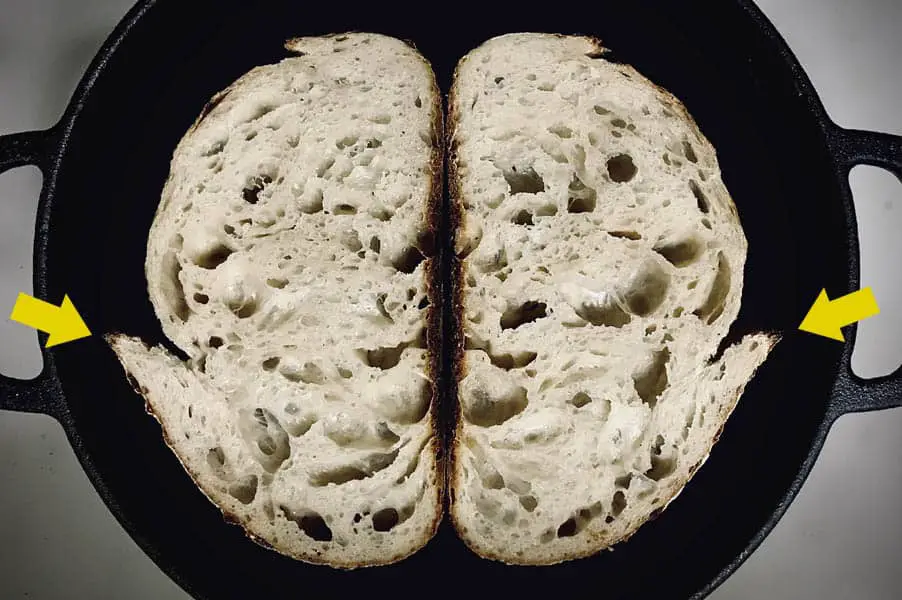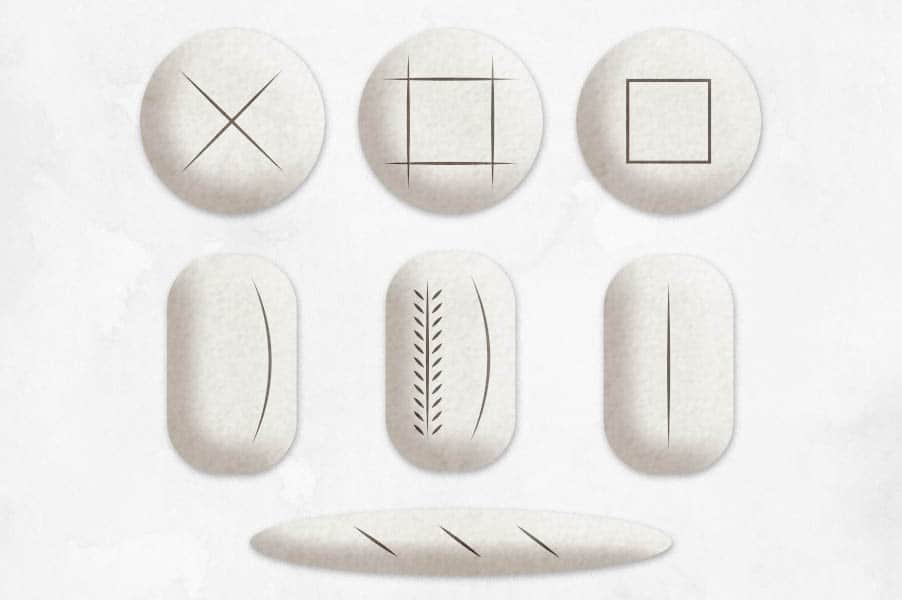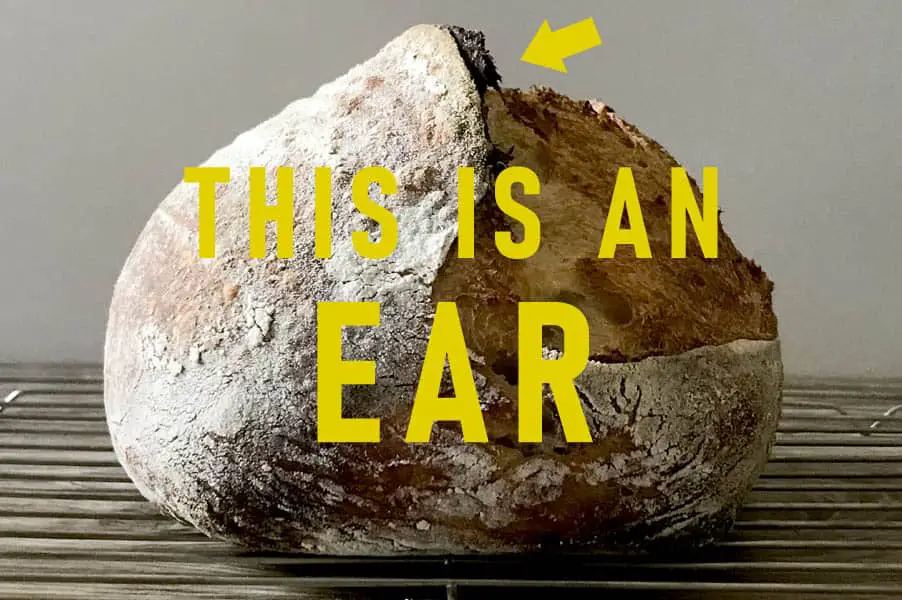I remember these days. 🙂 I was watching some videos over on youtube and folks kept talking about ears on their bread and I had no idea what they meant. Us hobbyists tend to completely forget that we adopt a completely different vocabulary than the rest of the human population when talking about our craft. Whatever the craft might be, it seems to be universal. 🙂
An ear on sourdough, and bread in general, refers to a portion of raised crust that develops as bread rises during baking. An ear forms when bakers slice their dough just before baking using shallow angled cuts, called scoring, in order to encourage expansion in a controlled pattern or shape.
Essentially, it’s crust that rolls up creating a point that resembles a dog ear, or cat ear.
The best way to describe it though is to show you an example. In the post thumbnail above, you can see the outside, but here is what the ear looks like on the inside. Which gives more of the reasoning for how it got the term ear. As it actually looks a bit like a dog ear, or cat ear once cut into.

How To Get An Ear?
Getting an ear is relatively simple, as it just involves rotating your blade or lame (rhymes with mom) so that it is a little less than parallel to the surface of your dough. No need not fuss about being just right here, as long as you’re at about a 45° angle you’ll produce a decent ear.
One thing to point out is that ears are most often more beneficial on long loaves, like batards (short oval loaves) and baguettes (long and thin classic french loaves). They’re also easier to achieve this way. Boules (round loves) fare better with cross-sections being formed. Those patters are typically a cross, square, or tic-tac-toe board. Check out the image below, and I’ll see you on the other side.

The four non-round loaves in the image above will produce excellent ears if you slice at an angle so that the blade is closer to parallel with the dough. Cutting with your blade at a 90° angle will produce a decent rise, but it will not produce an ear (unless there is more than normal rise in the bake).
Why Are Ears So Popular in Baking?
Ears are popular for two main reasons.
Aesthetics: They look beautiful when done well. And we eat with our eyes first, as they say. Slicing in this way is exactly what long oval loaves need to achieve a uniform rise in the oven. If you’ve wondered how professionals get such uniform looking loaves, it primarily comes down to shaping and scoring. By uniform I mean, the entire loaf has even rise without one spot sticking out or caving in. This also has to do with proper fermentation and proofing, but shaping and scoring work together to ensure you get the most uniform look.
Maximum Rise: Achieving the best rise involves giving dough a headstart toward achieving the most rise possible. The way that baker’s score dough greatly determines the potential rise. Crumb, is largely dependent on rise, especially how dense or airy it will be. The scoring pattern has a big part in all loaves, but the angle of slicing and achieving an ear also plays a big part in ovals as well. When the crust rolls up to form an ear, depending on where you place it, the bread is given room to actually expand in a nearly uniform dome shape on top. The ear expands in such a way that allows moist dough to be exposed for a longer period from across the entire top of the loaf as it rolls up, which helps keep things expanding evenly.
You can see the difference in uniform rise and height in different scoring techniques in the video below. The first couple of loaves show a great example of what an ear does.
It is not needed for good rise, and you can go your whole life baking amazing bread without ever getting an ear. But they give batards their best fighting chance to reach for the stars. Contrary to what I initially thought when we first got into baking, it goes beyond just looks.
Do I Need A Lame To Get Ears?
Lames (rhymes with moms), do make things easier when scoring dough. At least, razor blades do. Lames make using a razor blade a bit more safe than just handling a razor blade on its own. However, they are not needed to score dough nor are they needed to create ears.
For scoring dough, you just need a sharp knife that is fairly thin. A good tomato knife works really well. I wouldn’t recommend anything large. It will just get in the way, especially if you score with your dough inside a Dutch oven.
Try Scoring With Cold Dough To Make Ears Easier
One last tip on scoring, to get you on your way. If you’ve struggled to get a good ear on your dough. It might have to do with scoring warm dough. Dough that is out at room temp is a lot harder to work with. Cold dough on the other hand, is stiff and tends to score much better. If you can’t seem to get a good angle because your dough is just way too stretchy and sticky, give cold dough a try.
What If I’m Doing All Of This And Still No Ears?
If you’re really struggling to get a good ear, there are two main areas to consider.
Rise: You just might not be getting enough rise during the bake to get a good ear, or you might not be getting enough early rise. Ensure that your bread is not over or under-proofed to correct the first issue. There a many ways to do this, but primarily follow your recipe to the letter, ensuring that you are proofing with the right dough temperature and room temperature. Also, ensure that your oven is piping hot to correct the second issue. You need a lot of initial heat to really blow the “lid” (make the ear roll-up) off of your dough.
Moisture: This is highly likely if you’re not using a Dutch oven. Dutch ovens help trap moisture in and allow for the crust to remain pliable longer into the bake. This helps the ear fully develop as the dough rises longer into the bake. If not using a Dutch oven, do all that you can to get steam in your oven and keep it in there. We spray the top of our dough with a water bottle right before putting it in the oven and place water in a hot pan inside the oven to create a lot of initial steam.

